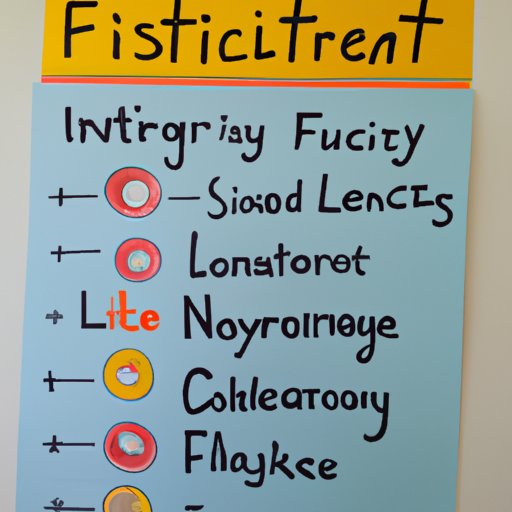Introduction
Financial literacy is defined as “the ability to understand and use various financial skills, including personal financial management, budgeting, and investing.” In today’s world, it’s more important than ever for individuals to possess these skills in order to make sound financial decisions throughout their lives. Unfortunately, there is a lack of attention paid to financial literacy in many schools across the country. This article will explore the importance of teaching financial literacy in schools, the different approaches available, and the potential impact on student outcomes.
Benefits of Teaching Financial Literacy in Schools
Teaching financial literacy in schools has many benefits, both for the students and society as a whole. According to a study by the Organisation for Economic Co-operation and Development (OECD), “students who receive financial education are more likely to develop the abilities and attitudes necessary to make informed financial decisions.” Here are some of the key benefits of teaching financial literacy in schools:
Improved Financial Decision-Making Skills
One of the primary benefits of teaching financial literacy in schools is that it helps students develop the skills needed to make informed financial decisions. This includes understanding the basics of budgeting, saving, and investing. With this knowledge, students are better equipped to make wise choices about their finances, such as avoiding credit card debt and taking advantage of tax deductions.
Increased Understanding of Investments and Other Financial Products
Another benefit of teaching financial literacy in schools is that it helps students gain a better understanding of investments and other financial products. This includes learning how to evaluate stocks, bonds, mutual funds, and other investment options. With this knowledge, students can make informed decisions when it comes to investing their money and creating a diversified portfolio.
Development of Money Management Skills
Finally, teaching financial literacy in schools helps students develop the skills needed to manage their money. This includes learning how to create a budget and stick to it, as well as understanding the basics of credit and debt. With this knowledge, students can make smart decisions about their finances, such as avoiding high-interest loans and using credit cards responsibly.
Why Financial Literacy Should be a Priority for Schools
Given the numerous benefits of teaching financial literacy in schools, it’s clear that this should be a priority for educational institutions. Here are some of the reasons why financial literacy should be a priority for schools:
Provide Students with Life Skills that Will Benefit Them in Adulthood
One of the primary reasons why financial literacy should be a priority for schools is that it provides students with life skills that will benefit them in adulthood. These skills include budgeting, saving, investing, credit and debt management, and more. With this knowledge, students can make informed financial decisions that will set them up for success in the future.
Empower Students to Make Sound Financial Decisions Throughout Their Lives
Another reason why financial literacy should be a priority for schools is that it empowers students to make sound financial decisions throughout their lives. By teaching students the basics of budgeting and investing, they can make smarter choices when it comes to spending and saving their money. This knowledge will serve them well into adulthood and help them achieve financial security.

Different Approaches to Teaching Financial Literacy
When it comes to teaching financial literacy in schools, there are several different approaches that can be taken. Here are some of the most common approaches to teaching financial literacy in schools:
Traditional Classroom Instruction
One approach to teaching financial literacy in schools is through traditional classroom instruction. This approach involves lectures and discussions on topics such as budgeting, investing, and credit and debt management. This method allows students to learn the basics of financial literacy in an interactive setting.
Online Courses
Another approach to teaching financial literacy in schools is through online courses. These courses provide students with an in-depth look at topics such as budgeting, investing, and credit and debt management. Online courses are often self-paced and can be completed from the comfort of home.
Hands-on Activities
Finally, another approach to teaching financial literacy in schools is through hands-on activities. This could involve having students create budgets or invest virtual money in the stock market. These activities allow students to get a firsthand experience with financial concepts and put their newfound knowledge into practice.

Impact of Financial Literacy on Student Outcomes
In addition to providing students with the skills needed to make sound financial decisions, teaching financial literacy in schools can also have a positive impact on student outcomes. Here are some of the ways that teaching financial literacy can impact student outcomes:
Improved Academic Performance
A study conducted by the University of Missouri found that students who received financial literacy instruction had higher grades in math and English than those who did not. This suggests that teaching financial literacy can have a positive effect on academic performance.
Enhanced Career Prospects
Another way that teaching financial literacy can have a positive impact on student outcomes is by enhancing career prospects. According to a study by the National Endowment for Financial Education, students who received financial literacy instruction had improved career prospects, as they were better able to understand and navigate workplace scenarios involving financial decisions.

Strategies for Incorporating Financial Literacy into the Curriculum
Incorporating financial literacy into the curriculum can be challenging, but there are several strategies that schools can use to make the process easier. Here are some of the strategies that schools can utilize to incorporate financial literacy into the curriculum:
Working with Local Businesses or Organizations
One strategy for incorporating financial literacy into the curriculum is to work with local businesses or organizations. This could involve inviting guest speakers to discuss financial topics or having students visit businesses to observe how financial decisions are made. This is a great way to bring real-world examples into the classroom.
Incorporating Real World Examples
Another strategy for incorporating financial literacy into the curriculum is to incorporate real world examples. This could involve having students analyze current events related to finance or having them research stocks and mutual funds. This helps students understand how financial concepts apply to the real world.
Utilizing Technology and Interactive Games
Finally, another strategy for incorporating financial literacy into the curriculum is to utilize technology and interactive games. This could involve having students use online simulations to practice budgeting or playing financial literacy-themed video games. This helps make the material engaging and fun for students.
Conclusion
In conclusion, teaching financial literacy in schools is an important part of preparing students for success in the future. It helps students develop the skills needed to make sound financial decisions and provides them with the knowledge necessary to manage their money. Additionally, teaching financial literacy can have a positive impact on student outcomes, such as improved academic performance and enhanced career prospects. Schools should utilize strategies such as working with local businesses or organizations, incorporating real world examples, and utilizing technology and interactive games to make the process of incorporating financial literacy into the curriculum easier.
Overall, teaching financial literacy in schools is essential for helping students become financially responsible adults. It’s important for schools to prioritize financial literacy education in order to ensure that students have the skills and knowledge needed to make sound financial decisions throughout their lives.
(Note: Is this article not meeting your expectations? Do you have knowledge or insights to share? Unlock new opportunities and expand your reach by joining our authors team. Click Registration to join us and share your expertise with our readers.)
